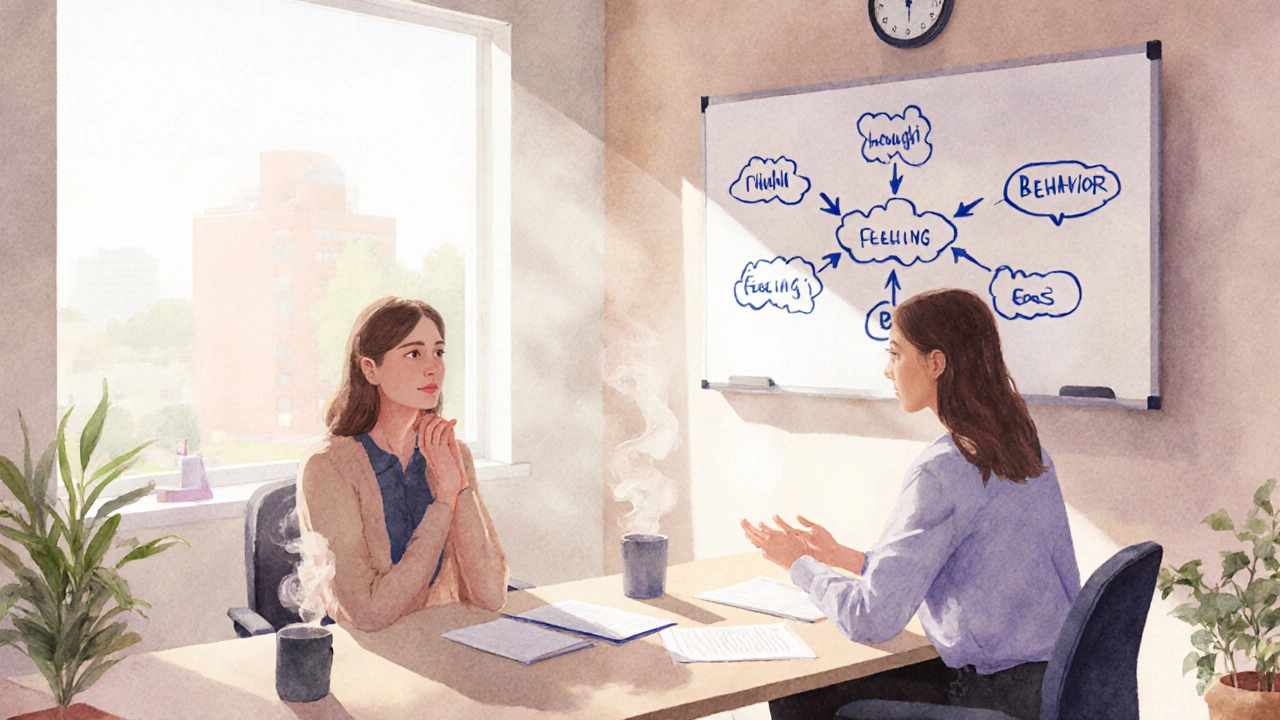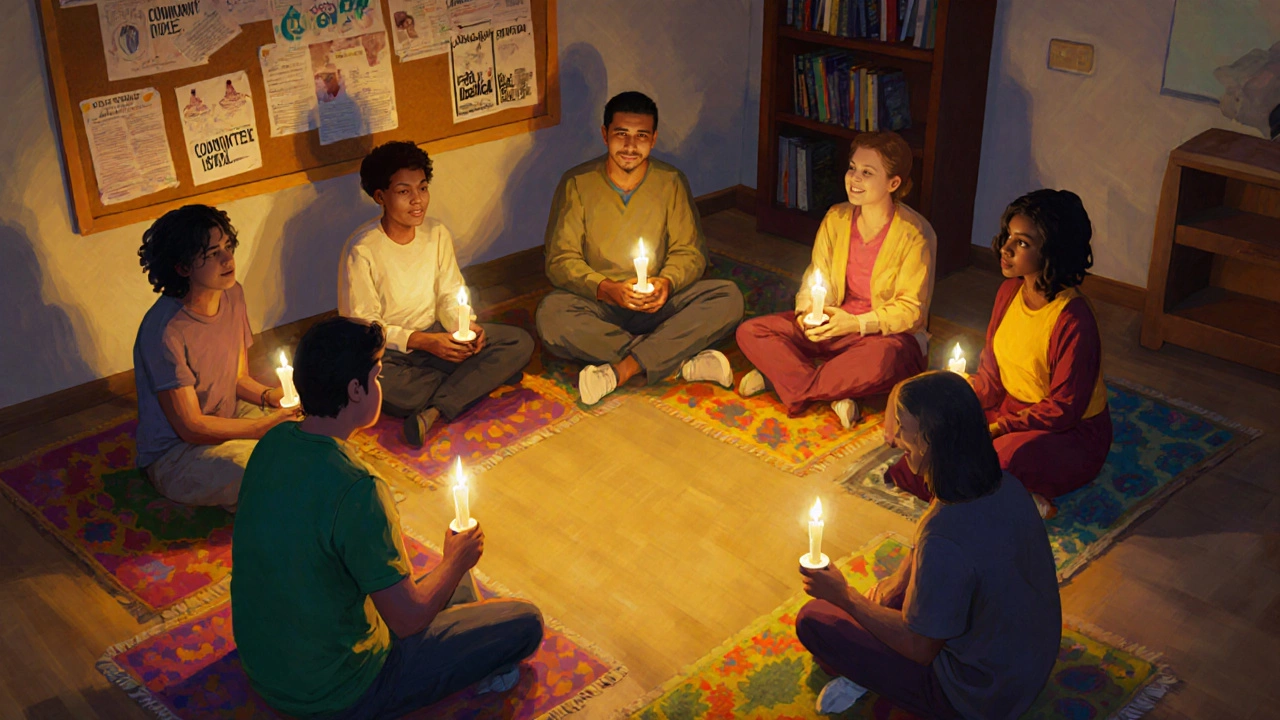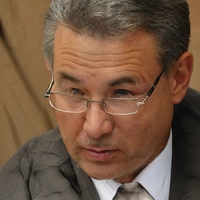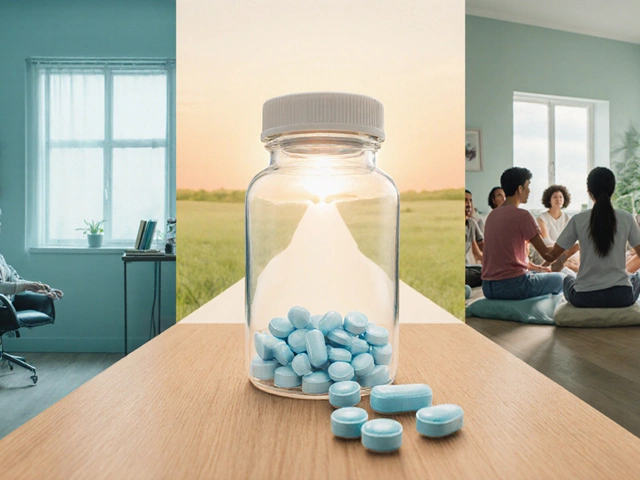Mental Health Help Comparison Tool
Select a category below to learn more about its key features and benefits:
Talk-based healing with professionals
Chemical balance through drugs
Community-led care from shared experience
Selected Category Information
Click on one of the cards above to see detailed information about each type of mental health support.
| Aspect | Psychotherapy | Medication | Peer Support |
|---|---|---|---|
| Primary Goal | Change thought-behavior patterns | Stabilize neurochemical activity | Provide shared experience and coping tools |
| Typical Provider | Licensed therapist or psychologist | Psychiatrist or prescribing clinician | Trained peer facilitator or volunteer |
| Evidence of Effectiveness | Effect size 0.7-0.8 for anxiety/depression | 30-50% symptom reduction for many disorders | 22-30% reduction in symptom scores (peer-led studies) |
| Cost (average) | Free-public / $100-$250 per session private | Generics under $10/month to $200+/month brand-name | Often free or low-cost through community organizations |
When you or someone you care about faces a mental disorder, knowing where to turn can feel overwhelming. mental health support is a broad term that covers the professional, medical, and community resources designed to improve emotional well‑being and daily functioning. In this guide we break down the three most common categories of help-psychotherapy, medication, and peer‑based support-so you can spot the right option for your situation, understand what to expect, and take the first step with confidence.
Quick Takeaways
- Psychotherapy offers structured talk‑based treatment tailored to thoughts, feelings, and behaviors.
- Medication addresses chemical imbalances and can stabilize symptoms, often used alongside therapy.
- Peer support connects you with people who have lived experience, providing empathy, shared coping tools, and community.
- Choosing the right mix depends on diagnosis, personal preference, cost, and accessibility.
- Start by consulting a primary‑care doctor or a trusted mental‑health professional to map a personalized plan.
Why These Three?
Research from the World Health Organization shows that a combination of psychological and pharmacological interventions yields the best outcomes for most disorders. Meanwhile, peer‑led groups have been shown to reduce hospitalization rates by up to 30% for conditions like depression and schizophrenia. The three categories-therapy, meds, and peer support-cover the full spectrum of evidence‑based care, from clinical to community‑driven.
1. Psychotherapy: Talk‑Based Healing
Psychotherapy, also called counseling or talk therapy, involves regular sessions with a trained mental‑health professional who helps you explore thoughts, emotions, and behaviors. Cognitive‑behavioral therapy (CBT) is the most widely studied approach, focusing on identifying distorted thinking patterns and replacing them with healthier alternatives. Other common modalities include dialectical behavior therapy (DBT) for emotional regulation, acceptance and commitment therapy (ACT) for mindfulness, and psychodynamic therapy for insight into unconscious influences.
- Typical providers: Licensed psychologists, clinical social workers, counselors, and psychiatric nurses.
- Settings: Private practices, community mental‑health centers, hospitals, and telehealth platforms.
- Session length & frequency: 45‑60minutes, usually weekly or bi‑weekly.
- Cost: Varies-public health systems may offer free or subsidized care; private rates range $100‑$250 per session in the US, £70‑£150 in the UK, or NZ$120‑$200 in NewZealand.
Effectiveness data from a 2023 meta‑analysis of 150 CBT trials reported an average effect size of 0.78 for anxiety disorders and 0.69 for depression, indicating substantial improvement over control conditions.

2. Medication: Chemical Balance
Psychotropic medication works by altering neurotransmitter activity in the brain. Antidepressants (SSRIs, SNRIs), antipsychotics (second‑generation), anxiolytics (benzodiazepines, buspirone), and mood stabilizers (lithium, valproate) are the main drug classes used across diagnoses.
- Typical prescribers: Psychiatrists, primary‑care physicians, nurse practitioners with prescribing authority.
- Settings: Out‑patient clinics, hospitals, tele‑psychiatry services.
- Onset & monitoring: Most meds need 2‑6weeks to show benefits; regular blood tests may be required for lithium or clozapine.
- Cost: Generic SSRIs can be under $10/month in many countries; brand‑name antipsychotics may exceed $200/month without insurance.
According to a 2024 Cochrane review, combining antidepressants with CBT produced a 15% higher remission rate for major depressive disorder than medication alone, underscoring the value of an integrated approach.
3. Peer Support: Community‑Led Care
Peer support harnesses the lived experience of people who have navigated mental health challenges. Groups can be face‑to‑face, online forums, or phone‑based networks. Mental health peer‑run clubs often run under the guidance of a facilitator but focus on mutual aid rather than professional therapy.
- Typical formats: Support groups (e.g., Depression and Bipolar Support Alliance), recovery colleges, crisis helplines, and moderated online communities.
- Key benefits: Reduced stigma, practical coping tips, increased sense of belonging, and often zero cost.
- Effectiveness: A 2022 randomized trial of peer‑led weekly meetings for adults with anxiety showed a 22% reduction in GAD‑7 scores after three months.
Peer support doesn’t replace professional care but can fill gaps-especially in rural areas where access to clinicians is limited.
Comparison of the Three Types
| Aspect | Psychotherapy | Medication | Peer Support |
|---|---|---|---|
| Primary Goal | Change thought‑behavior patterns | Stabilize neurochemical activity | Provide shared experience and coping tools |
| Typical Provider | Licensed therapist or psychologist | Psychiatrist or prescribing clinician | Trained peer facilitator or volunteer |
| Evidence of Effectiveness | Effect size 0.7‑0.8 for anxiety/depression | 30‑50% symptom reduction for many disorders | 22‑30% reduction in symptom scores (peer‑led studies) |
| Cost (average) | Free‑public / $100‑$250 per session private | Generics <$10/month; brand‑names $100‑$300/month | Typically free or nominal donation |
| Accessibility | Urban centers, telehealth, some rural clinics | Widely available via pharmacies | High, especially online forums and crisis lines |

How to Choose the Right Mix
There’s no one‑size‑fits‑all recipe. Start with a brief assessment-either with a trusted doctor or a mental‑health professional-and ask these questions:
- What is the primary diagnosis? (e.g., depression, schizophrenia, PTSD.)
- How severe are the symptoms? (Mild, moderate, severe.)
- Do I have any medical conditions that affect medication choice?
- What are my personal preferences-talk‑based work, medication, or community interaction?
- What resources are available locally or online, and what can I afford?
For many people, a stepped approach works best: begin with a low‑dose antidepressant while starting CBT, then add a peer‑support group once you feel comfortable sharing. If medication side effects become troublesome, your clinician can adjust dosage or switch classes.
Common Pitfalls and How to Avoid Them
- Assuming one option will fix everything. Most guidelines recommend combined treatment for moderate‑to‑severe disorders.
- Stopping medication abruptly. Taper under medical supervision to prevent withdrawal or relapse.
- Choosing a therapist based solely on price. Verify credentials (e.g., LCSW, PsyD) and look for a specialization that matches your diagnosis.
- Ignoring cultural or language needs. Many community centers offer services in multiple languages-reach out to local NGOs if English isn’t your first language.
- Under‑utilizing peer groups. Even a brief weekly check‑in can reinforce coping strategies learned in therapy.
Next Steps: Putting Knowledge Into Action
1. Schedule a primary‑care appointment. Ask for a mental‑health referral or a prescription if you think medication may help.
2. Research local therapists. Use directories from professional bodies (e.g., APA, NZ Psychological Society) to verify licensing.
3. Explore peer‑support options. Search for groups on platforms like Meetup, local NGOs, or national helplines such as Lifeline (NZ), Samaritans (UK), or the National Suicide Prevention Lifeline (US).
4. Set a simple goal. Whether it’s attending one therapy session, filling a prescription, or joining a weekly group, a concrete action builds momentum.
5. Track progress. Keep a brief journal of mood, sleep, and functional changes; share it with your provider to fine‑tune the plan.
Frequently Asked Questions
Can I use therapy without medication?
Yes. For mild to moderate depression, anxiety, or PTSD, evidence shows that psychotherapy alone can lead to significant improvement. However, if symptoms are severe or if there’s a risk of self‑harm, clinicians often recommend adding medication for faster stabilization.
How long does it take to see results from medication?
Most antidepressants, antipsychotics, and mood stabilizers begin to show noticeable benefits after 2‑4 weeks, though full therapeutic effect may take up to 8‑12 weeks. Regular follow‑up appointments help monitor side effects and adjust dosage.
Are online peer‑support groups safe?
Most reputable platforms have trained moderators, privacy policies, and clear community guidelines. Choose groups affiliated with recognized NGOs or mental‑health charities to reduce the risk of misinformation.
What if I can’t afford therapy?
Many countries provide publicly funded mental‑health services based on income. In NewZealand, you can access free counseling through District Health Boards. Sliding‑scale clinics, university training programs, and telehealth apps often offer reduced fees.
Do I need a diagnosis before seeking help?
A formal diagnosis is not required to start therapy or join a peer group. However, a diagnosis helps clinicians choose the most effective medication and tailor therapeutic techniques, so a brief clinical assessment is usually beneficial.


